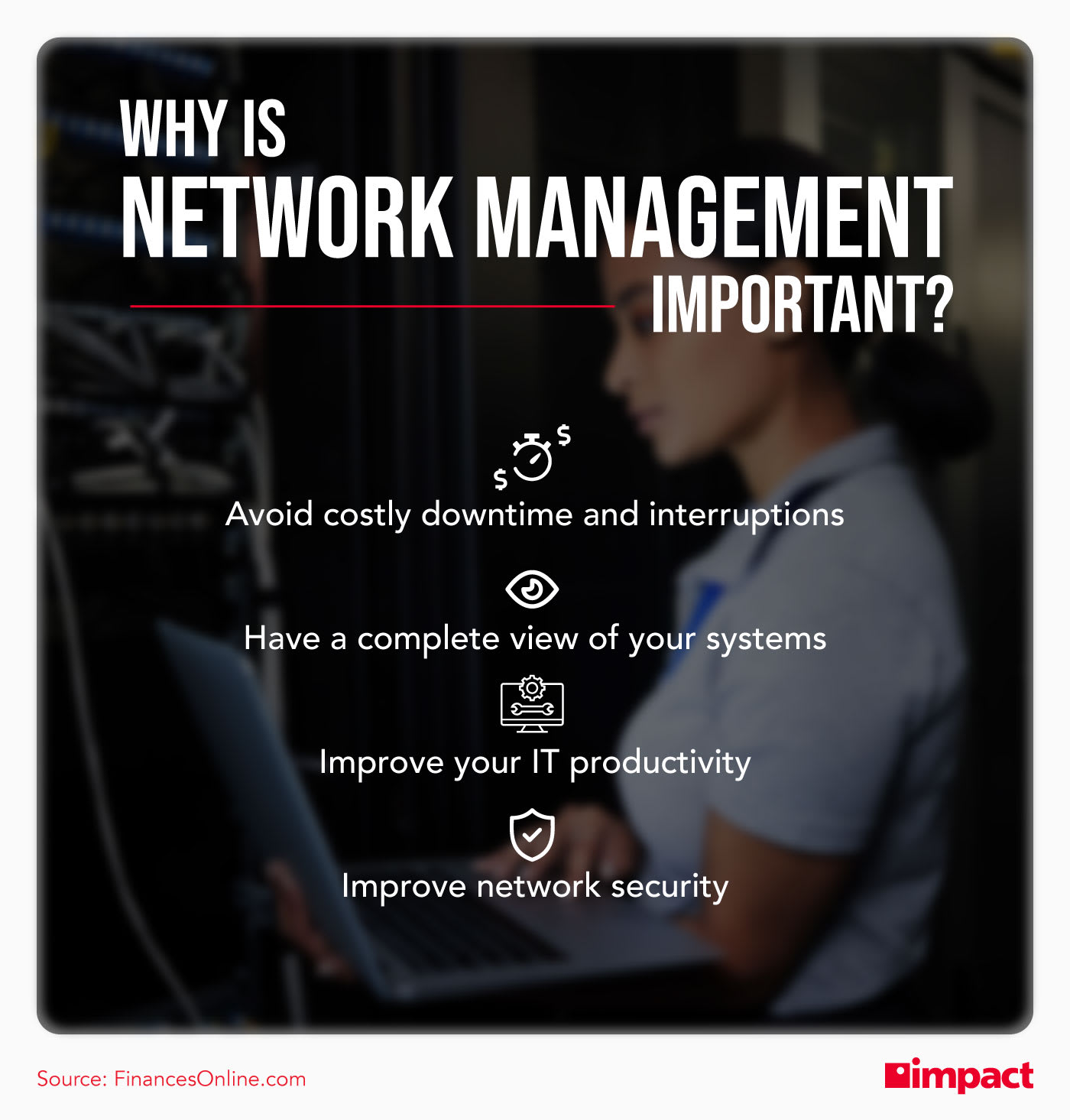Having a healthy network that’s well supported is a priority for organizations both big and small to maintain daily operations. This is what network management is all about – building and sustaining a network on which your business can rely.
Network management is defined as: a group of practices designed to keep your business network healthy including monitoring, maintenance, and regular updates. This is achieved through a series of tools that minimize downtime and facilitate smooth operations across daily workflows.
As businesses continue adopting new technologies, shifting their data to the cloud, and embracing IoT solutions for their processes, a network management strategy is no longer optional.
“Because IT networks play such a critical role in business operations, communications and collaboration, superior network management is important in enabling an enterprise to operate smoothly, compete effectively and innovate with ease.”
If all this is starting to feel overwhelming for you to handle yourself, read Impact’s eBook, Does Your Business Need a Managed IT Services Provider?
What Are the Key Aspects Network Management?
When addressing your IT network management, it’s important to have an understanding of the four key components involved so you can build a comprehensive solution.
- Administration
- Maintenance
- Provisioning
- Security
Let’s explore each of these components of network management in more depth below.
1. Administration
Network administration acts as the central nervous system for IT network management. It encompasses the planning, design, and implementation of strategies that ensure smooth network operation. This involves creating policies that govern network access, usage, and security.
Administrators define password complexity requirements, establish acceptable use policies, and set data security protocols. They also configure network devices like routers, switches, and firewalls to enable proper communication and functionality within the network.
Additionally, network administration involves managing user and device accounts. This includes adding, removing, and managing user accounts and network devices, along with assigning permissions and access levels to users and ensuring proper device registration.
Finally, network administrators play a crucial role in monitoring and troubleshooting network performance. They keep a watchful eye on network health, identify and resolve issues that may arise, and work towards optimization.
2. Maintenance
Network maintenance refers to the ongoing care and upkeep required to maintain a robust infrastructure. It involves regular activities like installing software patches, firmware updates, and security fixes for devices. These updates address vulnerabilities and improve overall performance.
Network maintenance also encompasses physical maintenance of network components like cables and connectors. This preventive maintenance ensures proper functioning of the physical infrastructure through cleaning, testing, and replacing aging equipment when necessary.
Additionally, network maintenance involves performance optimization. Administrators regularly review network usage patterns to identify bottlenecks or areas for improvement. This could involve making adjustments to network configurations or upgrading bandwidth to optimize network efficiency.
Lastly, a comprehensive network maintenance strategy includes developing and maintaining a backup and recovery plan for network data and configurations. This ensures a swift recovery process in the event of unexpected outages or hardware failures.
3. Provisioning
Network provisioning focuses on preparing and allocating resources for new devices or users. This process involves analyzing current network usage and forecasting future needs to ensure sufficient resources are available for new additions.
It also encompasses setting up and configuring new devices for connection to the network. This may involve pre-configuring settings and ensuring compatibility with existing infrastructure.
Additionally, network provisioning involves creating user accounts with appropriate access levels based on user roles and needs. Security configuration is also a crucial aspect of network provisioning. Administrators ensure that new devices and users comply with network security policies by implementing necessary security measures.
4. Security
Network security is a constantly evolving aspect that focuses on protecting the network from unauthorized access, malicious attacks, and data breaches. It involves implementing access control mechanisms like firewalls, access control lists (ACLs), and user authentication to limit access to resources.
Network administrators also play a vital role in vulnerability management. They regularly scan for vulnerabilities in devices, software, and configurations. Identified weaknesses are then remediated to strengthen defenses.
Additionally, network security strategies include deploying intrusion detection and prevention systems. These systems help detect and prevent unauthorized access attempts, malware infiltration, and other security threats.
Finally, network security involves data encryption, a technique that secures sensitive data at rest and in transit. Encryption prevents unauthorized access to sensitive information, even if it is intercepted.
Final Thoughts on Network Management
While there are a lot of aspects involved with network management, it’s pivotal that organizations establish a proper strategy that minimizes downtime and supports their daily workflows and operations. Without a reliable network, modern businesses will struggle to win and maintain market share, face costly downtime, and can even create unnecessary security flaws.
By prioritizing your network health through a standardized managed network and connectivity service, you create a better overall customer experience, reduce wasted costs due to downtime, and improve your overall security.
Having a reliable network is absolutely critical for modern businesses. If you’re dealing with more downtime than necessary, read Impact’s eBook, Does Your Business Need a Managed IT Services Provider?

